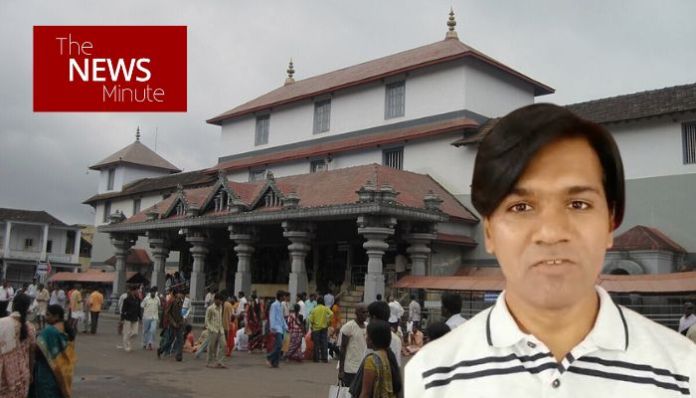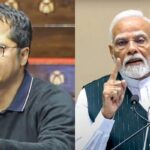In July this year, the temple town of Dharmasthala was hurled into a storm of sensational allegations. A former sanitation worker, C.N. Chinnaiah, claimed that between 1995 and 2014, he had buried “hundreds of bodies” in the region, victims of murders that were allegedly hushed up. His testimony, unbacked by a shred of evidence, was enough for the Congress-led Karnataka government to constitute a Special Investigation Team. For two weeks, SIT officers scoured forests, riverbanks, and ghats, looking for mass graves.
Yet as the dust settles, the story stands exposed as a monumental hoax. C.N. Chinnaiah was arrested by the SIT and produced before the Belthangady court, where he confessed to lying. His testimony crumbled during questioning. What he revealed was even more damning: he was just a pawn in a larger conspiracy.
Dharmasthala hox whistleblower arrested, confesses to being a part of a larger conspiracy
According to reports, Chinnaiah admitted to SIT investigators that he was recruited in Tamil Nadu late last year. A group of masterminds approached him, offered money, and promised protection if he played his role. They told him his fabricated testimony would trigger outrage, cause a domino effect, and prompt others to come forward. He would not need to fear consequences, because once the scandal was mainstream, the temple would be tarnished, and he would be shielded.
“I was given training in Bengaluru,” he reportedly told investigators. “I was told how to answer when questioned by the police. I would act as the mastermind instructed. I am just the character here; the mastermind was someone else.”
Chinnaiah even tried to bolster his falsehood with props. He presented a skull to the court, claiming it belonged to one of the victims he buried. But when pressed, he could not reveal where he had obtained it. His inconsistencies piled up. SIT officers confirmed that 17 of the 18 sites he pointed to yielded nothing. At one spot, bones were recovered, but preliminary inquiry showed they belonged to a recent case of suicide. Forensic analysis will confirm the details, but the larger narrative already lies in tatters.
The mask has truly fallen off. What was presented as a witness of conscience was in fact a stage-managed pawn in a conspiracy to malign Dharmasthala, its temple trust, and dharmadhikari Veerendra Heggade.
Propaganda machinations: Amplifying unwarranted allegations against Hindu temple under the guise of ‘journalism’
The narrative was powerful in its theatrics: a town renowned for its temple, dharmic traditions, and charity allegedly hiding a mass killing field. For weeks, the media treated the story as a serious national issue.
And yet, the investigation yielded nothing. No mass graves were found, no crimes substantiated. Finally, the whistleblower himself was arrested by Karnataka Police for providing false information. The Dharmasthala horror story collapsed under the weight of reality.
But what remained was the damage. The reputational injury to Dharmasthala, the insinuations cast on the Sree Dharmasthala Manjunatheshwara Temple Trust, and the smearing of its dharmadhikari, Veerendra Heggade. It was a
The more important question, however, is how an allegation so fantastical, so lacking in evidence, managed to gain mainstream traction. And the answer lies in the ecosystem of propaganda that thrives in today’s media, an ecosystem in which The News Minute and its editor Dhanya Rajendran play a crucial role.
Every conspiracy that gains ground has identifiable actors. There is the originator who makes the claim, the political forces who weaponise it, the ecosystem of activists and influencers who circulate it, and most critically, the amplifiers, the respectable media outlets that give the allegation legitimacy under the cloak of carrying out “balanced” and “measured” journalism.
The News Minute falls into this category. It never directly accused Dharmasthala, but its relentless coverage of each allegation, its grave contextualisation of every SIT update, and its insistence on treating the claims as worthy of national attention sustained the narrative long after it should have died. By repeatedly reporting the allegations, TNM transformed a baseless story into a live controversy. Thus, far from reporting facts, the issue morphed into one where Dharmasthala and its famous temple became a focal point of uninformed discussions and unwarranted vilification.

This is the subtlety of propaganda by amplification. TNM did not hurl wild accusations; it merely gave them space, analysis, and oxygen. But had the allegation been about madrassas engaging in mass rapes, or a mosque hiding criminal activity, would The News Minute have treated it with the same “balanced” seriousness? Would it have hosted explainers and timelines on the possibility of hundreds of Hindu girls trafficked through religious networks? The answer is obvious, as witnessed on countless instances in the past.
The “nuanced” and “balanced” coverage appears only when the target is Hindu institutions. When it is about sexual crimes in churches or radicalisation programs running in mosques, The News Minute very conveniently ignores to report them or simply try to underplay such incidents.
The bias in covering Dharmasthala hoax vis-a-vis Ajmer scandal, Kerala Story, and Uttarakhand encroachments
The bias becomes even more glaring when contrasted with the Ajmer sex scandal verdict of August 20, 2024. After thirty-two years of legal struggle, a district court sentenced six men to life imprisonment for the mass rape and blackmail of over 100 schoolgirls in Ajmer in the early 1990s. The accused were not nobodies. They included leaders of the Ajmer Youth Congress like Farooq Chishti, Nafees Chishti, and Anwar Chishti, along with Khadims of the Ajmer Dargah.
The victims were mostly Hindu girls, many of whom were trapped, raped, photographed, and then blackmailed into bringing more girls into the network. Some were driven to suicide. It was one of the largest sex scandals in Indian history, politically and communally charged, with immense implications. And yet, The News Minute, which breathlessly covered unsubstantiated claims against Dharmasthala, had virtually nothing to say about Ajmer. No special coverage, no timelines, no grave explainers. The verdict of one of India’s most notorious crimes was buried in silence.
The same selectivity marked TNM’s coverage of The Kerala Story. When a film depicted the testimonies of women lured into relationships, converted, and trafficked as ISIS brides, TNM routinely dismissed it as a propaganda movie. The victims’ own words, their harrowing ordeal, were brushed aside because the perpetrators in the story were Islamists.
A real case of grooming, trafficking, and radicalisation was downplayed and ridiculed, while an entirely fictitious claim of mass murders in Dharmasthala was elevated into a national controversy. This inversion of priorities reveals a pattern: amplify unproven allegations against Hindus, dismiss proven crimes by Islamists, and erase stories where Hindus are the victims.
This pattern also extends to stories of illegality and encroachment. In Devbhoomi Uttarakhand, authorities uncovered multiple cases of mosques and Islamic seminaries illegally occupying government land, forest areas, and even pilgrimage routes. These encroachments led to demolitions and political confrontations, with clear documentary evidence of wrongdoing.
But here too, The News Minute was absent. There were no series of investigative reports, no timelines tracing the illegalities, no editorial outrage about land-grab by religious institutions. The same newsroom that displayed unhealthy obsession with Dharmasthala’s fabricated scandal had no appetite for investigating real encroachments by Islamic institutions in Uttarakhand. By choosing what not to cover, TNM effectively ensured that Hindu institutions alone are projected as suspect, while Islamic ones escape scrutiny.
The same goes for instances of Love Jihad, which seldoms finds a mention in The News Minute’s coverage. And when it does, the ‘media’ outlet often dismisses it as a figment of ‘Right-Wing imagination’, insulting the sufferings of thousands, if not lakhs of women, who have been through the horror of Love Jihad — victimised by Muslim men who lure them into a relationship under false pretences, only to force them to convert and coerce them into abiding Islamic edicts.

Propaganda amplifiers: How Zubair aided The News Minute and others to propagate Dharmasthala hoax
The ecosystem that sustained the Dharmasthala hoax also reveals how propaganda gains reach. Figures like Mohammed Zubair and Pratik Sinha of Alt News, and journalists aligned with Newslaundry, often amplify these “nuanced” reportage by means of tweeting and sharing reports on social media with the unstated aim of showing the Hindu institutions in the bad light. It cannot be denied that by propagating such baseless conspiracies, such characters try to effect public opinion on why Hindu places of worship should continue to remain under government control — a phenomenon vigorously opposed by vociferous public speakers like Dr Anand Ranganathan and J. Sai Deepak.
Nevertheless, when such characters shared TNM’s coverage, it lended an additional layer of credibility to the myth that Dhanya and her organisation was trying to weave. Zubair even hailed The News Minute for its relentless coverage of the Dharmasthala story, using their reports to amplify his own agenda against Hindu institutions. But once the SIT found nothing, once the whistleblower himself was arrested, Zubair quietly deleted his celebratory tweet. Not a word of apology, no clarification, no acknowledgement of error.

The retreat was as silent as the initial amplification was loud. This is their method: amplify Hindu “wrongdoing” aggressively, but shamelessly scoot away when the narrative falls apart. For some time now, Zubair and his ilk has been expertly deploying this weapon — attack Hindu beliefs from someone else’s shoulders and make a dash when held accountable. When this strategy fails to work, he does what he is best at: selective amnesia.
Zubair is notorious for unleashing Sar Tan Se Juda gang against former BJP spokesperson Nupur Sharma after he accused her of making remarks against Prophet Muhammad in 2022. More than three years later, Zubair is yet to offer a “fact check” to prove what Nupur said was fake. He continues to evade responding to queries on his “fact-check” on Nupur’s claims.
And the hypocrisy becomes staggering when we recall that in cases where Muslim clerics are convicted of raping minors inside mosques, or when mosques are demolished for illegal encroachment, this entire ecosystem suddenly develops amnesia. The relentless coverage model applies only one way. The same Zubair who nitpicks Hindu priests’ speeches forgets to highlight when Muslim clerics make contentiously communal remarks. The same TNM that runs explainers on Dharmasthala conspiracies cannot find space for Ajmer, for Uttarakhand encroachments, or for victims of Islamist grooming.
The trap of false moral equivalence
The wider strategy behind this selective outrage is the creation of false equivalence. Every time a real scandal implicates Muslims—Ajmer, Bishop Franco, ISIS recruitment—the ecosystem tries to construct a Hindu counter-scandal. Thus “Bhagwa Love Trap” is invented to counter “Love Jihad.” “Jai Shri Ram” is equated with “Allahu Akbar” so that there is always a Hindu equivalent ready to balance and rationalise extremism as not being exclusive just to Islam. Rationalist murders are used to paint Hinduism as intolerant, equating it with Abrahamic blasphemy laws. Dharmasthala’s hoax was useful in this sense: to create a manufactured Hindu horror story to balance the weight of Ajmer or Kerala Story, to ensure that no one community appears uniquely culpable.
Seen from an engineering perspective, the propaganda pipeline is efficient. Allegations enter as raw material. Amplifiers like The News Minute process them into “serious issues.” Propaganda peddlers like Zubair and Sinha distribute them widely. Political actors and paid social media trolls then try to build a narrative that pushes such conspiracy theories into national discourse, where truth becomes the first casualty and sensationalism takes precedence. When proven false, the feedback loop is silence, deletion, and denial of responsibility. By then, the reputational damage is already done.
How Hindu institutes are just one manufactured allegation away from vilification
The unravelling of Chinnaiah and his admission that he was tutored, rewarded, and directed by others should end this scandal once and for all. But it must also serve as a warning. Dharmasthala was not just a hoax; it was a case study in how Hindu institutions are vulnerable to manufactured narratives. It showed how easily a temple town could be smeared, how quickly “neutral” media could amplify lies, and how seamlessly propagandists could ride on that coverage.
Meanwhile, Hindu tragedies like Ajmer are ignored, Hindu victims of grooming are dismissed as propaganda, and Islamic institutions caught in illegality are shielded by silence. Until this cycle of selective outrage is exposed and confronted, every Hindu institution remains one manufactured allegation away from vilification, and every Hindu victim remains one editorial choice away from erasure. Dharmasthala’s hoax has collapsed, but the ecosystem that birthed it is very much alive, and it is perhaps on the prowl for another Dharmasthala to vilify.













